2004 Hyundai Santa Fe child seat
[x] Cancel search: child seatPage 14 of 253

1
Fuel Recommendations ................................................ 1-2
Breaking in Your New Hyundai ..................................... 1-3
Keys.............................................................................. 1-3
Door.............................................................................. 1-4
Power Windows..........................................................1-10
Seats...........................................................................1-11
Seat Belts....................................................................1-18
Child Restraint System...............................................1-24
Supplemental Restraint (AIRBAG) system .................1-31
Instrument Cluster and Indicator Lights ...................... 1-38
Warning and Indicator Lights ......................................1-42
Multi-Function Light Switch.........................................1-48
Windshield Wiper/Washer Switch...............................1-50
Sunroof.......................................................................1-56
Mirror...........................................................................1-61
Hood Release.............................................................1-72
Cruise Control.............................................................1-75
Heating and Cooling Control .......................................1-78
Stereo Sound System.................................................1-94
Audio System..............................................................1-96
Antenna.....................................................................1-1231
FEATURES OF YOUR HYUNDAI
Page 17 of 253
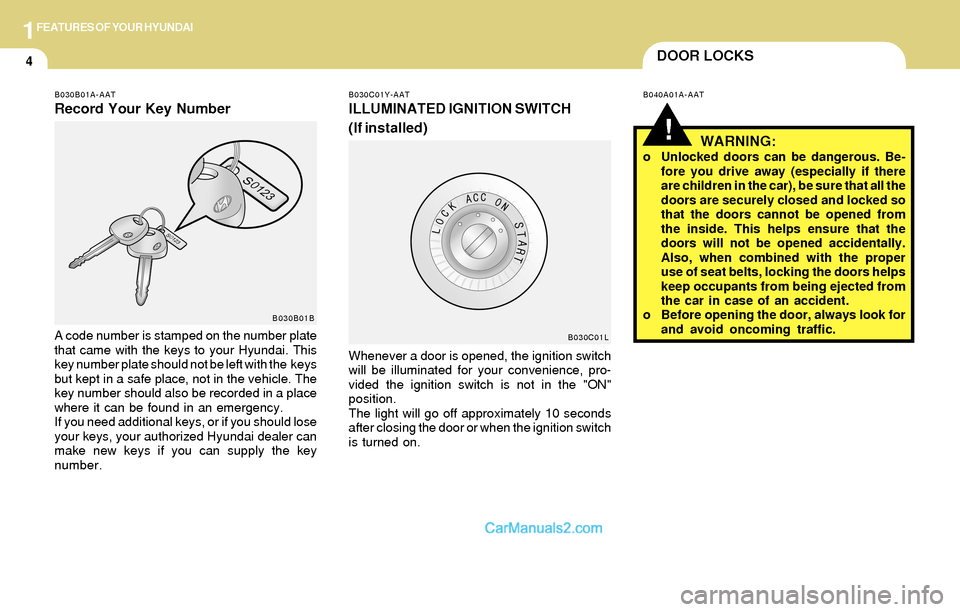
1FEATURES OF YOUR HYUNDAI
4DOOR LOCKS
!
B040A01A-AATB030C01Y-AAT
ILLUMINATED IGNITION SWITCH
(If installed)
Whenever a door is opened, the ignition switch
will be illuminated for your convenience, pro-
vided the ignition switch is not in the "ON"
position.
The light will go off approximately 10 seconds
after closing the door or when the ignition switch
is turned on.
B030C01L
WARNING:o Unlocked doors can be dangerous. Be-
fore you drive away (especially if there
are children in the car), be sure that all the
doors are securely closed and locked so
that the doors cannot be opened from
the inside. This helps ensure that the
doors will not be opened accidentally.
Also, when combined with the proper
use of seat belts, locking the doors helps
keep occupants from being ejected from
the car in case of an accident.
o Before opening the door, always look for
and avoid oncoming traffic.
B030B01A-AAT
Record Your Key Number
A code number is stamped on the number plate
that came with the keys to your Hyundai. This
key number plate should not be left with the keys
but kept in a safe place, not in the vehicle. The
key number should also be recorded in a place
where it can be found in an emergency.
If you need additional keys, or if you should lose
your keys, your authorized Hyundai dealer can
make new keys if you can supply the key
number.
B030B01B
Page 20 of 253
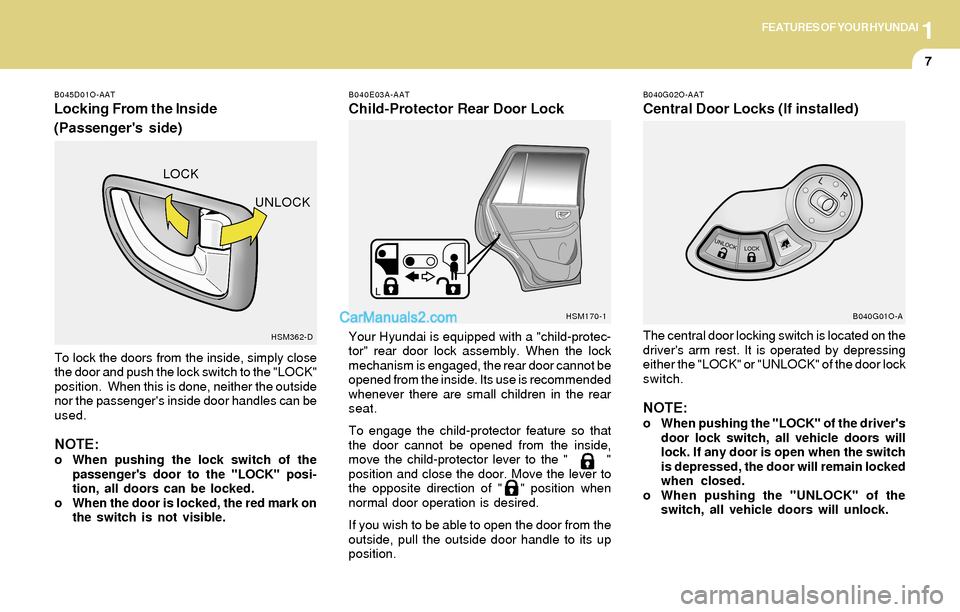
1FEATURES OF YOUR HYUNDAI
7
B040E03A-AAT
Child-Protector Rear Door Lock
Your Hyundai is equipped with a "child-protec-
tor" rear door lock assembly. When the lock
mechanism is engaged, the rear door cannot be
opened from the inside. Its use is recommended
whenever there are small children in the rear
seat.
To engage the child-protector feature so that
the door cannot be opened from the inside,
move the child-protector lever to the " "
position and close the door. Move the lever to
the opposite direction of " " position when
normal door operation is desired.
If you wish to be able to open the door from the
outside, pull the outside door handle to its up
position.
B045D01O-AAT
Locking From the Inside
(Passenger's side)
To lock the doors from the inside, simply close
the door and push the lock switch to the "LOCK"
position. When this is done, neither the outside
nor the passenger's inside door handles can be
used.
NOTE:o When pushing the lock switch of the
passenger's door to the "LOCK" posi-
tion, all doors can be locked.
o When the door is locked, the red mark on
the switch is not visible.
HSM362-DHSM170-1
LOCK
UNLOCK
B040G02O-AAT
Central Door Locks (If installed)
The central door locking switch is located on the
driver's arm rest. It is operated by depressing
either the "LOCK" or "UNLOCK" of the door lock
switch.
NOTE:o When pushing the "LOCK" of the driver's
door lock switch, all vehicle doors will
lock. If any door is open when the switch
is depressed, the door will remain locked
when closed.
o When pushing the "UNLOCK" of the
switch, all vehicle doors will unlock.
B040G01O-A
Page 24 of 253

1FEATURES OF YOUR HYUNDAI
11SEATS
!
In order to prevent operation of the passenger
front and rear windows, a window lock switch(2)
is provided on the armrest of the driver's door.
To disable the power windows, press the win-
dow lock switch. To revert to normal operation,
press the window lock switch a second time.
NOTE:The power windows can be operated for 30
seconds after the ignition key is turned to
the "ACC" or "LOCK" positions, or removed
from the ignition switch.
If the front doors are opened during this 30
second period, the power windows can no
longer be operated without the ignition key
turned to the "ON" position.
WARNING:(1) Be careful that someone's head, hands
and body are not trapped by a closing
window.
(2) Never try to operate the main switch on
the driver's door and the individual door
window switch in opposing directions
at the same time. If this is done, the
window will stop and cannot be opened
or closed.
(3) Do not leave children alone in the car.
Always remove the ignition key for their
safety.
HSM050
HSM441-A
(2)Open Close
B080A01A-AAT
ADJUSTABLE FRONT SEATS
!WARNING:Never attempt to adjust the seat while the
vehicle is moving. This could result in loss
of control or an accident which may cause
death, serious injury, or property damage.
Page 31 of 253
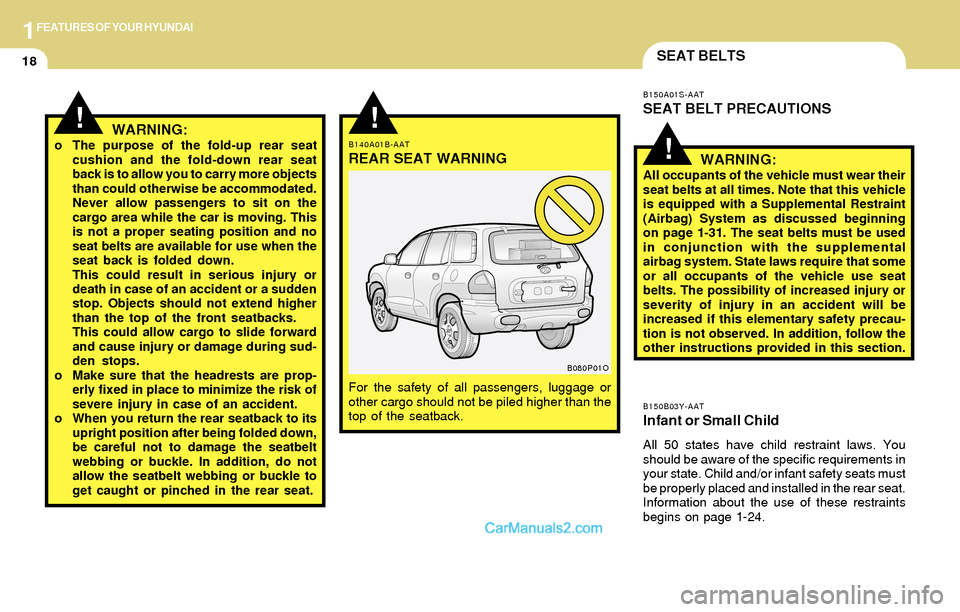
1FEATURES OF YOUR HYUNDAI
18SEAT BELTS
B150B03Y-AATInfant or Small Child
All 50 states have child restraint laws. You
should be aware of the specific requirements in
your state. Child and/or infant safety seats must
be properly placed and installed in the rear seat.
Information about the use of these restraints
begins on page 1-24.
!
!B140A01B-AATREAR SEAT WARNING
For the safety of all passengers, luggage or
other cargo should not be piled higher than the
top of the seatback.
WARNING:o The purpose of the fold-up rear seat
cushion and the fold-down rear seat
back is to allow you to carry more objects
than could otherwise be accommodated.
Never allow passengers to sit on the
cargo area while the car is moving. This
is not a proper seating position and no
seat belts are available for use when the
seat back is folded down.
This could result in serious injury or
death in case of an accident or a sudden
stop. Objects should not extend higher
than the top of the front seatbacks.
This could allow cargo to slide forward
and cause injury or damage during sud-
den stops.
o Make sure that the headrests are prop-
erly fixed in place to minimize the risk of
severe injury in case of an accident.
o When you return the rear seatback to its
upright position after being folded down,
be careful not to damage the seatbelt
webbing or buckle. In addition, do not
allow the seatbelt webbing or buckle to
get caught or pinched in the rear seat.
B080P01OB150A01S-AAT
SEAT BELT PRECAUTIONS
WARNING:
All occupants of the vehicle must wear their
seat belts at all times. Note that this vehicle
is equipped with a Supplemental Restraint
(Airbag) System as discussed beginning
on page 1-31. The seat belts must be used
in conjunction with the supplemental
airbag system. State laws require that some
or all occupants of the vehicle use seat
belts. The possibility of increased injury or
severity of injury in an accident will be
increased if this elementary safety precau-
tion is not observed. In addition, follow the
other instructions provided in this section.
!
Page 32 of 253
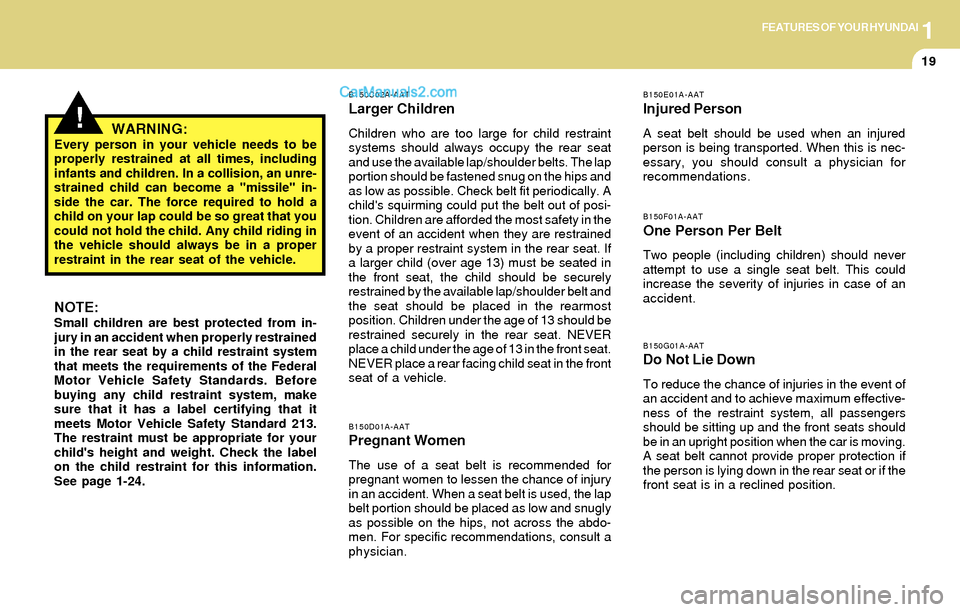
1FEATURES OF YOUR HYUNDAI
19
!
B150C02A-AAT
Larger Children
Children who are too large for child restraint
systems should always occupy the rear seat
and use the available lap/shoulder belts. The lap
portion should be fastened snug on the hips and
as low as possible. Check belt fit periodically. A
child's squirming could put the belt out of posi-
tion. Children are afforded the most safety in the
event of an accident when they are restrained
by a proper restraint system in the rear seat. If
a larger child (over age 13) must be seated in
the front seat, the child should be securely
restrained by the available lap/shoulder belt and
the seat should be placed in the rearmost
position. Children under the age of 13 should be
restrained securely in the rear seat. NEVER
place a child under the age of 13 in the front seat.
NEVER place a rear facing child seat in the front
seat of a vehicle.
B150D01A-AATPregnant Women
The use of a seat belt is recommended for
pregnant women to lessen the chance of injury
in an accident. When a seat belt is used, the lap
belt portion should be placed as low and snugly
as possible on the hips, not across the abdo-
men. For specific recommendations, consult a
physician.
B150E01A-AAT
Injured Person
A seat belt should be used when an injured
person is being transported. When this is nec-
essary, you should consult a physician for
recommendations.
B150F01A-AAT
One Person Per Belt
Two people (including children) should never
attempt to use a single seat belt. This could
increase the severity of injuries in case of an
accident.
B150G01A-AATDo Not Lie Down
To reduce the chance of injuries in the event of
an accident and to achieve maximum effective-
ness of the restraint system, all passengers
should be sitting up and the front seats should
be in an upright position when the car is moving.
A seat belt cannot provide proper protection if
the person is lying down in the rear seat or if the
front seat is in a reclined position.
WARNING:Every person in your vehicle needs to be
properly restrained at all times, including
infants and children. In a collision, an unre-
strained child can become a "missile" in-
side the car. The force required to hold a
child on your lap could be so great that you
could not hold the child. Any child riding in
the vehicle should always be in a proper
restraint in the rear seat of the vehicle.
NOTE:Small children are best protected from in-
jury in an accident when properly restrained
in the rear seat by a child restraint system
that meets the requirements of the Federal
Motor Vehicle Safety Standards. Before
buying any child restraint system, make
sure that it has a label certifying that it
meets Motor Vehicle Safety Standard 213.
The restraint must be appropriate for your
child's height and weight. Check the label
on the child restraint for this information.
See page 1-24.
Page 35 of 253
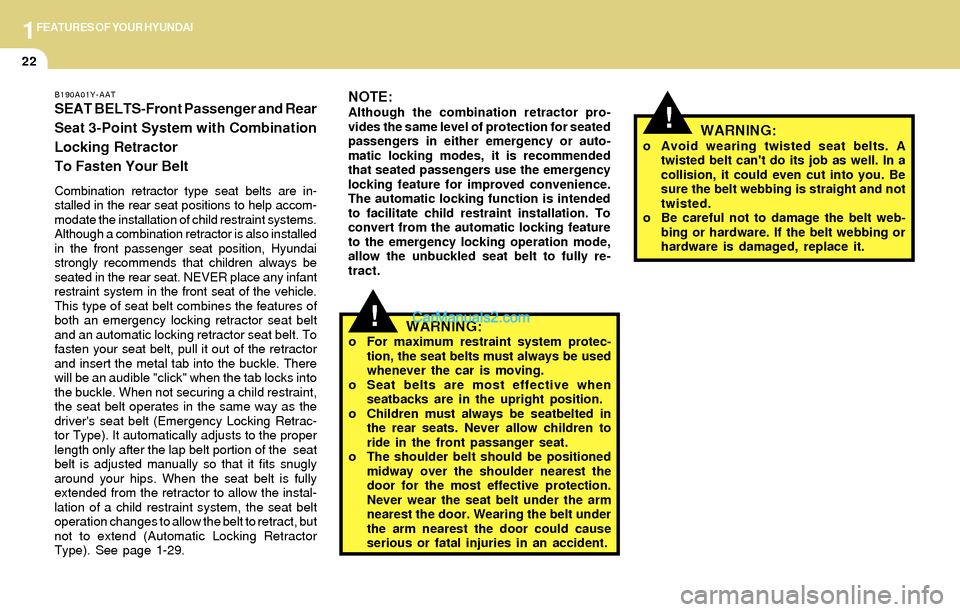
1FEATURES OF YOUR HYUNDAI
22
!
NOTE:Although the combination retractor pro-
vides the same level of protection for seated
passengers in either emergency or auto-
matic locking modes, it is recommended
that seated passengers use the emergency
locking feature for improved convenience.
The automatic locking function is intended
to facilitate child restraint installation. To
convert from the automatic locking feature
to the emergency locking operation mode,
allow the unbuckled seat belt to fully re-
tract.
WARNING:o For maximum restraint system protec-
tion, the seat belts must always be used
whenever the car is moving.
o Seat belts are most effective when
seatbacks are in the upright position.
o Children must always be seatbelted in
the rear seats. Never allow children to
ride in the front passanger seat.
o The shoulder belt should be positioned
midway over the shoulder nearest the
door for the most effective protection.
Never wear the seat belt under the arm
nearest the door. Wearing the belt under
the arm nearest the door could cause
serious or fatal injuries in an accident.
B190A01Y-AAT
SEAT BELTS-Front Passenger and Rear
Seat 3-Point System with Combination
Locking Retractor
To Fasten Your Belt
Combination retractor type seat belts are in-
stalled in the rear seat positions to help accom-
modate the installation of child restraint systems.
Although a combination retractor is also installed
in the front passenger seat position, Hyundai
strongly recommends that children always be
seated in the rear seat. NEVER place any infant
restraint system in the front seat of the vehicle.
This type of seat belt combines the features of
both an emergency locking retractor seat belt
and an automatic locking retractor seat belt. To
fasten your seat belt, pull it out of the retractor
and insert the metal tab into the buckle. There
will be an audible "click" when the tab locks into
the buckle. When not securing a child restraint,
the seat belt operates in the same way as the
driver's seat belt (Emergency Locking Retrac-
tor Type). It automatically adjusts to the proper
length only after the lap belt portion of the seat
belt is adjusted manually so that it fits snugly
around your hips. When the seat belt is fully
extended from the retractor to allow the instal-
lation of a child restraint system, the seat belt
operation changes to allow the belt to retract, but
not to extend (Automatic Locking Retractor
Type). See page 1-29.
WARNING:o Avoid wearing twisted seat belts. A
twisted belt can't do its job as well. In a
collision, it could even cut into you. Be
sure the belt webbing is straight and not
twisted.
o Be careful not to damage the belt web-
bing or hardware. If the belt webbing or
hardware is damaged, replace it.
!
Page 37 of 253
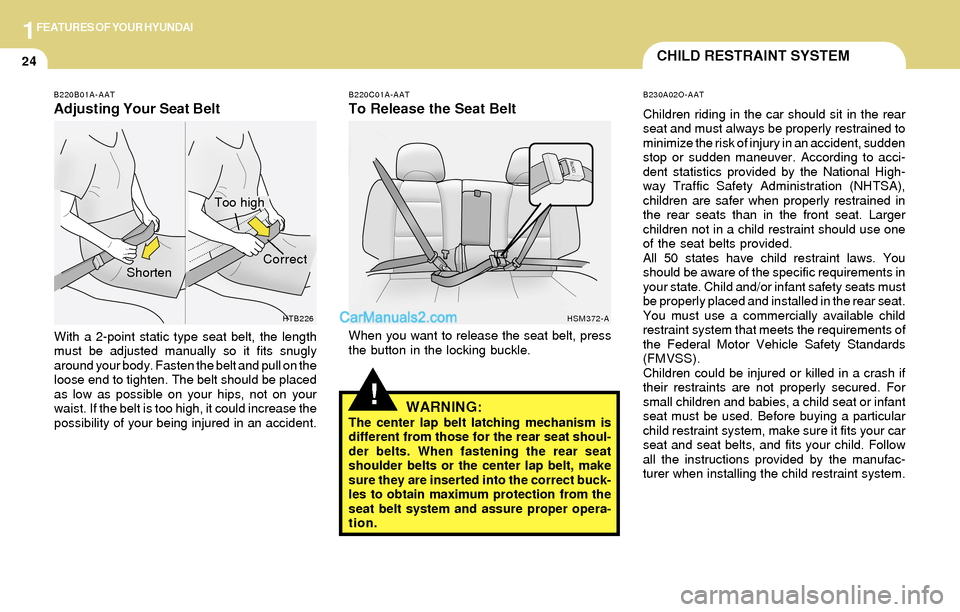
1FEATURES OF YOUR HYUNDAI
24CHILD RESTRAINT SYSTEM
!
B230A02O-AAT
Children riding in the car should sit in the rear
seat and must always be properly restrained to
minimize the risk of injury in an accident, sudden
stop or sudden maneuver. According to acci-
dent statistics provided by the National High-
way Traffic Safety Administration (NHTSA),
children are safer when properly restrained in
the rear seats than in the front seat. Larger
children not in a child restraint should use one
of the seat belts provided.
All 50 states have child restraint laws. You
should be aware of the specific requirements in
your state. Child and/or infant safety seats must
be properly placed and installed in the rear seat.
You must use a commercially available child
restraint system that meets the requirements of
the Federal Motor Vehicle Safety Standards
(FMVSS).
Children could be injured or killed in a crash if
their restraints are not properly secured. For
small children and babies, a child seat or infant
seat must be used. Before buying a particular
child restraint system, make sure it fits your car
seat and seat belts, and fits your child. Follow
all the instructions provided by the manufac-
turer when installing the child restraint system.
B220C01A-AAT
To Release the Seat Belt
When you want to release the seat belt, press
the button in the locking buckle.
WARNING:The center lap belt latching mechanism is
different from those for the rear seat shoul-
der belts. When fastening the rear seat
shoulder belts or the center lap belt, make
sure they are inserted into the correct buck-
les to obtain maximum protection from the
seat belt system and assure proper opera-
tion.
HSM372-A
B220B01A-AAT
Adjusting Your Seat Belt
With a 2-point static type seat belt, the length
must be adjusted manually so it fits snugly
around your body. Fasten the belt and pull on the
loose end to tighten. The belt should be placed
as low as possible on your hips, not on your
waist. If the belt is too high, it could increase the
possibility of your being injured in an accident.
HTB226
ShortenCorrect
Too high